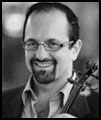
|
Crescendo
Sasha Margolis
|
Violinists look forward to Beethoven’s concerto
You are in bed at night when someone knocks, five times, at your neighbor's door. You get up and, by the light of a candle, write those five knocks down on music paper, transforming them into five kettle-drum strikes. At least, that's what you do if you are Ludwig van Beethoven and you are writing the beginning of your only violin concerto.
'Great Composers'
Honolulu Symphony with conductor Jean-Marie Zeitouni and violinist Vadim Gluzman:
» In concert: 8 p.m. Saturday and 4 p.m. Sunday
» Place: Hawaii Theatre
» Tickets: $22 to $75; $10 students and their chaperones
» Call: 528-0506 or visit hawaiitheatre.com
|
'And if you are a violinist performing the same concerto? You simply sit back and enjoy yourself. I, and the other violinists in the orchestra, feel very lucky to be playing this piece this week. We get to take part in what is unquestionably one of the greatest pieces written for our instrument. And we get to listen to the soloist -- in this case, the stellar Vadim Gluzman -- more than we might in another concerto. Here's why:
Unlike many concertos, the Beethoven is big -- monumentally big. It encompasses more thought and emotion than a solo voice alone can convey. As violinist George Enescu put it: "This is a great symphony. The violin has a leading voice, but it is merely one of the many orchestral voices which make up the whole."
Many of the voices Enescu is talking about belong to the woodwind family (flutes, clarinets, oboes, bassoons), although let's not forget the timpani (kettle drum). Usually, violin sections get the lion's share of the melodies -- and we love it that way. (Maybe that's why we become violinists.) But in this piece, when the soloist isn't playing, the winds, which contrast more with the sound of the soloist, often take over.
Together, these voices create music that is sweeping, touching, dramatic. As Gluzman puts it, the writing is "so personal that it speaks directly to our hearts, yet so objective as to encompass the whole world in one bar." And it still features a spectacular, and spectacularly difficult, solo part.
Beethoven is best known for dramatic music that constantly changes and develops. The second movement of this concerto, once described as "one of the most mysteriously serene pieces of music ever composed," is an exception. It is a story, masquerading as a song, masquerading as a violin piece, rooted in a poetic style that emphasizes simple, repeating verses and an old-fashioned, pastoral mood. The third movement, far from being serene, is joyfully rambunctious.
Two other wonderful pieces round out our concert program: Copland's famous, stirring "Fanfare for the Common Man" and Dvorak's Symphony No. 8, which positively overflows with rich Slavic dance and song.
I'm particularly excited, too, about this concert, because our conductor will be Jean-Marie Zeitouni. I played 12 performances of Offenbach's opera "Orpheus in the Underworld" under his direction this summer. To be frank, Offenbach's musically unadventurous opera was not one I had looked forward to playing more than once or twice. Far from being bored, however, I loved every minute of it, thanks to Maestro Zeitouni. His physical expressiveness, musical brilliance and spontaneity will have you enjoying every minute of this concert as well.
Sasha Margolis is a Honolulu Symphony violinist.

